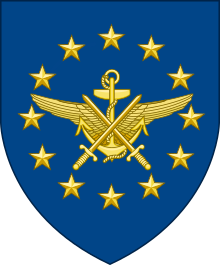European Union Military Staff
 | |
| Location | |
|---|---|
| Website | http://eeas.europa.eu/csdp/structures-instruments-agencies/eu-military-staff/index_en.htm |
The European Union Military Staff (EUMS) is a department of the European Union (EU), responsible for supervising operations within the realm of the Common Security and Defence Policy. It is directly attached to the private office of the High Representative of the Union for Foreign Affairs and Security Policy, currently Federica Mogherini, and is formally part of the European External Action Service.
Role
In addition to providing strategic advice to the High Representative, the EUMS reports to the European Union Military Committee (EUMC), an intergovernmental Council body made up of the Chiefs of Defence. Its main task is to perform "early warning, situation assessment and strategic planning for Petersberg tasks" and to implement CSDP missions (2001/80/CFSP, annex article 2) such as EUFOR Althea and the other European Union Force missions in Chad/CAR and the DR Congo. The EUMS current consists of 200+ military and civilian personnel.
The EUMS is located in the Kortenberg building, a short distance from the Berlaymont building, at Avenue de Kortenberg 150, B-1040 Brussels. Nearby is the Belgian Royal Military Academy building.

EUMS is headed by a Director General, since May 2013 Lieutenant General de, previously the military representative of Austria to the EU. He succeeded Lieutenant General Ton van Osch (2010-2013), Lieutenant General David Leakey (2007-2010) and FR Lieutenant General Jean-Paul Perruche (2004-2007). The Deputy Director General of the EUMS is Rear Admiral Bruce Williams from the UK.
The EUMS does not directly control the EU military missions. In order to conduct an EU military crisis management operation, an Operational Headquarters (OHQ) is nominated by the appropriate EU Council decision. The OHQ directs the Force Headquarters or FHQ, also provided by a member country, which carries out the operation on the ground. If an EU operation is planned and conducted with recourse to NATO assets and capabilities, the OHQ is automatically the NATO Allied Command Operations (ACO), formerly known as SHAPE, located in Mons, Belgium. In other cases, five national operational headquarters have been made available for use by the Union to fulfil the OHQ role. The French CPCO - Centre de Planification et de Conduite des Opérations - is situated at the à l'État major des Armées, 231 boulevard St Germain, in Paris. Near Paris also is the French Mont Valérien command-and-control facility, where a French declared OHQ for EU operations is located. (It is not clear if the French Mont Valerien facility has a national designation). The others are the British PJHQ at the Northwood Headquarters northwest of London, Germany's Armed Forces Operational Command near Potsdam, Centocelle in Rome and Larissa. The selected OHQ runs the operation at the strategic level. For example, Operation Artemis used Mont Valérien as its OHQ and EUFOR's DR Congo operation used Potsdam.[1] The second option is to use NATO facilities, under 'Berlin plus' arrangements, as was the case for mounting EUFOR Althea, for which SHAPE was used.[2]

The European Council decided in December 2004 to establish an additional OHQ option to those already in existence. The EU Military Staff (EUMS) was tasked to be ready to set up an OPSCEN capable of planning and conducting an operation, in particular where a joint civil/military response is required and where no national HQ is identified. The responsibility for assuring this capability lies with the OPSCEN/WKC (Watching Keeping Capacity) Branch of the EUMS Operations Directorate.Since 1 January 2007, the EU Operation Centre is ready for activation by the Council for the conduct of autonomous operations. It is not a standing, fully manned Headquarters. The permanent facilities - premises and the necessary equipment - enable the Council to establish, at very short notice, a fully-fledged Operations Centre for a particular operation. In the case of a predominantly military operation, its staff would be able to start planning five days following Ministers' decision. The staff of the EU Operations Centre, when so activated, would be composed of the permanent core team (the four permanent staff), double-hatted personnel from the EUMS and other parts of the EEAS, as well as further reinforcements from Member States. The Ops Directorate Branch Chief OPSCEN/WKC would become the Chief of Staff of the activated Operations Centre.
Operations supervised
The Military Staff has supervised a number of deployments since its establishment. The term EUFOR or European Union Force has been used to describe a number of military deployments, and has been used four times so far: in the Republic of Macedonia from March 2003 to December 2003 as EUFOR Concordia, in Bosnia from 2004 as EUFOR Althea, in the Democratic Republic of the Congo in 2006 (EUFOR DR Congo), and in Chad (EUFOR Tchad/RCA) and the Central African Republic since 2007. EUFOR is a temporary military deployment, not a permanent military force, and should not be confused with the Eurocorps, Eurofor or the Helsinki Headline Goal Force Catalogue, sometime misleadingly known as the 'European Rapid Reaction Force'. The name 'EUFOR' probably was patterned in imitation of NATO's IFOR, SFOR, and KFOR.
See also
- Franco-British Defence and Security Cooperation Treaty and Downing Street Declaration
- Common Foreign and Security Policy
- Common Security and Defence Policy
- Common_Security_and_Defence_Policy#Current_content_and_structure
- Military of the European Union
- General Secretariat of the Council of the European Union
- High Representative of the Union for Foreign Affairs and Security Policy
- Council of the European Union
- European Maritime Force (Euromarfor)
- European Gendarmerie Force (Eurogendfor)
- EU Battlegroup
- European Security Strategy
- European Defense Agency
- European defence procurement
- Overseas interventions of the European Union
